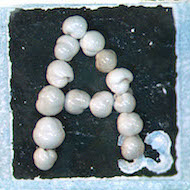
Fun with Forams
Recently, one of our paleontologists Petra Dekens celebrated her birthday on the JOIDES Resolution. Fellow paleontologist Lyndsey Fox decided to do something special and came up with this creative idea to write “Happy Birthday Petra” using foraminifera, the tiny fossils that the paleontology team spends their days trying to find and identify.
Foraminifera are single-celled marine organisms with shells made of calcium carbonate (CaCO3). They are usually less than 1mm in size, so about the size of a grain of salt. Foraminifera first appeared in the Early Cambrian – about 500 million years ago. There are an estimated 8000 species living in the world’s oceans today.
These little “bugs” as they are affectionately called onboard, eventually sink to the seafloor and are buried in the sediments. Because different species lived at different times in Earth’s history, they can tell us when the sediments were deposited. They can also be used to reconstruct past climate and ocean conditions (e.g., temperature). They are so important that we have six paleontologists on our expedition, three of whom specialize in identifying foraminifera.
Six different planktonic (floating) species were used in this mini birthday card. Their name, age range, distribution, and distinguishing features are described below. See if you can pick out the differences in shape!

16 (H), 32 (D), 40 (P):
Neogloboquadrina dutertrei
Late Pliocene (~3 million years ago) to recent
Tropical to warm subtropical
Rounded shell, 5-6 inflated chambers in the outer spiral, distinct pores

17 (A), 28 (I):
Globorotalia tumida
Late Miocene (~8 million years ago) to recent
Tropical
Large shell, 5-6 wedge-shaped chambers in the outer spiral that increase in size as added

18 (P), 19 (P), 33 (A), 43 (R):
Pulleniatina obliquiloculata
Early Pliocene (~4 million years ago) to recent
Tropical to warm subtropical
Rounded shell, smooth surface, aperture (primary opening of the shell) forms a low arch

20 (Y), 29 (R), 42 (T):
Globigerinoides sacculifer
Early Miocene (~20 million years ago) to recent
Tropical to warm subtropical
3.5 to 4 spherical chambers in the outer spiral, final chamber is largest and elongate, hexagonal (six-sided) pores

27 (B), 31 (H), 41 (E):
Orbulina universa
Early Miocene (~20 million years ago) to recent
Equatorial to subpolar
Single spherical chamber, surface densely covered in pores of two distinct sizes

30 (T),34 (Y), 44 (A):
Dentoglobigerina venezuelana
Mostly limited to Miocene (23 to 5 million years ago)
Tropical to warm subtropical
Large shell, surface covered in ornamental honeycomb-like surface ridges
